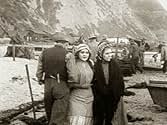Ajouter une intrigue dans votre langueIn this story set at a seaside fishing village and inspired by a Charles Kingsley poem, a young couple's happy life is turned about by an accident. The husband, although saved from drowning,... Tout lireIn this story set at a seaside fishing village and inspired by a Charles Kingsley poem, a young couple's happy life is turned about by an accident. The husband, although saved from drowning, loses his memory. A child is on the way, and soon a daughter is born to his wife. We watc... Tout lireIn this story set at a seaside fishing village and inspired by a Charles Kingsley poem, a young couple's happy life is turned about by an accident. The husband, although saved from drowning, loses his memory. A child is on the way, and soon a daughter is born to his wife. We watch the passage of time, as his daughter matures and his wife ages. The daughter becomes a l... Tout lire
- Villager
- (uncredited)
- Villager
- (uncredited)
- In Second Village
- (uncredited)
- Villager
- (uncredited)
- Villager
- (uncredited)
Avis en vedette
Years roll by Ms. Arvidson is a heartbroken woman, never knowing what happened to her husband. Their daughter (Mary Pickford, looking very grown-up) takes a husband of her own (Charles West), but mother remains alone. Then, Johnson's memory returns.
Griffith uses shots/time incredibly well - showing familiar scenes, like a static row of houses where Arvidson lives, changing over the years. "The Unchanging Sea" remains the same, but there are things happening in/on the sea which move the story. It's a lovely story, but the end is too sudden. I would have rather Griffith had the man return and never regain his memory, but fall in love with his wife all over again. The acting, direction and photography are exceptional.
******* The Unchanging Sea (5/5/10) D.W. Griffith ~ Arthur V. Johnson, Linda Arvidson, Mary Pickford
Key to this is Griffith's complex and daring use of cross-cutting, and in particular his narrowing the set-ups down to the minimum number of locations. The Biograph hierarchy were terrified that the story would be too confusing, but by re-using locations and camera set-ups the narrative becomes simplified and coherent. For example, when the father loses his memory and ends up separated from his family, perhaps the obvious thing would be to show him doing different things in different places as the years go by. Griffith however repeatedly shows him in that dilapidated dockyard, visually informing us that he is still stranded away from home, and still suffering from amnesia.
Griffith also saves time by having more than one thing going on each shot. In one scene we see the mother being courted by another sailor in the background, while her young daughter runs around near the sea in the background. Having two points of interest in the frame at one time shows Griffith's growing confidence in shot composition, and this is something he would gradually refine over his years with Biograph. Another important aspect is Griffith's frequent use of actors with their backs to the camera. Backs-to-the-audience is generally a no-no in theatre, but with the unlimited depth of the screen it becomes workable, and here it really adds power to the imagery.
Such was the strength of Griffith's visual storytelling, he almost did away with any need for intertitles. Here, the majority of the titles are lines from the Charles Kingsley poem upon which the picture is based. For Griffith, intertitles need not just be functional and explanatory, they could also be a kind of poetic commentary on the action.
The Unchanging Sea is a strong story told in moving pictures, although to be fair the Biograph bosses' fears were partly confirmed, because you do have to pay attention to follow it. In particular it can be a little confusing working out who is who. Griffith still had a fair way to go in developing characterisation and making individuals memorable, and this fact really stands out here.
The story, which moves across many years of life in a fishing community, is often moving, and the understated approach is effective. For the most part, the characters make only small gestures and changes of expression, and yet their reactions always seem sincere and heartfelt. It is effective both as cinema and as a portrayal of the sea-going community. Excessive drama or emotions would have overshadowed the substance of the story, rather than enhancing it. As a result, there is more worthwhile material in this short film than there is in many films that are several times as long.
Le saviez-vous
- ConnexionsEdited into Spisok korabley (2008)
Meilleurs choix
Détails
- Date de sortie
- Pays d’origine
- Langues
- Aussi connu sous le nom de
- Неизменчивое море
- Lieux de tournage
- sociétés de production
- Consultez plus de crédits d'entreprise sur IMDbPro
- Durée14 minutes
- Couleur
- Mixage
- Rapport de forme
- 1.33 : 1
Contribuer à cette page























